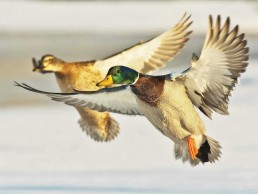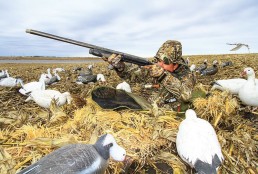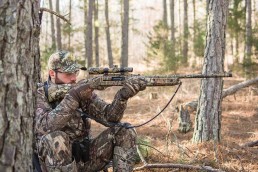Realism and Concealment: Bringing Wary Waterfowl to the Gun
SHARE THIS POST
Waterfowl hunting continues to evolve, especially when it comes to the realism we can put into today’s decoy spreads. Decoying ducks and geese is an ancient art dating back to early man, but it’s a great time to be practicing it now, because we have the best in fakes (and hunter concealment) we’ve ever had.
Equipment can greatly enhance the odds, but gear doesn’t necessarily define the hunt. Most ardent waterfowl hunters will agree that the right equipment combined with the right knowledge and experience gained in the marsh or field is the ultimate formula for success. This month, we interview a handful of hunters who have spent a tremendous amount of time scouting and laying in wait, looking up at the sky. We also take a look at some of the hottest new gear trends.
Spinning-wing decoys
Perhaps nothing has changed field duck hunting in the past 15 years more than spinning-wing decoys. Spinning-wing decoys continue to become more durable with better recharging systems and remotes that allow hunters to synchronize several decoys on one remote system. No more D batteries or wings that won’t last an entire season. With that being said, in the eyes of ducks, all spinning-wing decoys are equal if the wings are spinning fast enough to blur, according to Jason Mitchell, Passion for the Hunt TV host and long-time waterfowl guide near Devils Lake, North Dakota.
Mitchell, an astute judge of hunting gear and its effectiveness, offers up a few more tricks for using spinning-wing decoys when field hunting.
“I like to keep the stakes short,” he says, “so the ‘spinners’ are low to the ground, mixed in with the field decoys. Ducks can still see the spinners, but they don’t get as good a look at them as if they’re higher than the other decoys. On sunny days, stretch some women’s nylons over the wings to subdue the flash.”
Spinning-wing decoys can be critical for field hunting ducks at early light and are an important tool for many duck hunters. But, they can also “completely turn off conditioned or stale ducks,” says Mitchell. As a general rule, hunters have better success with spinning-wing decoys across the northern half of the flyways.
More hunters across the bottom half of the flyways are starting to appreciate motion decoys, however. Ducks might be stale to spinning-wing decoys by the time they reach Arkansas or Louisiana, but some other motion decoys can still be incredibly effective, particularly over water spreads.
Motion over water is nothing new, as hunters have used jerk cords to add some movement to decoy spreads for decades. There are some limitations, however, to jerk cords as you have to run a string from the blind to the decoy spread.
According to Ricky Hart of Lucky Duck Decoys and a regular on The Grind Waterfowl TV, motion decoys that swim, add ripples and splash, not only enhance the realism of the entire spread, but can also provide that flash of movement that catches the eyes of ducks, increasing the chances they’ll notice your spread.
“On calm days,” Hart says, “adding a couple quiver magnet XLs to a dozen decoys can create a ripple on the water that adds enough movement to make all the difference in the world.” (The quiver magnet XL is a battery-operated floating disk that vibrates, adding motion to still waters, enough to move floating decoys. And Lucky Duck also makes the HD Dabbler, a motion decoy that swims and can throw up spray like a feeding puddle duck.)
Flocking adds realism
Movement is one aspect of decoy-spread realism. Another hot trend is ‘flocking’ the finish on decoys.
Flocked decoys first became popular with Canada goose hunters, notably the black on Canada goose decoys. Recently, flocked duck decoys have gained believers, especially when it comes to treating the heads on drake mallard decoys.
“Flocked duck decoys make a huge difference on gray-sky days, because they look so much more real,” says Bill Willroth of Dakota Decoy Company and The Grind Waterfowl TV. “The contrast is so much better.”
Are you enjoying this post?
You can be among the first to get the latest info on where to go, what to use and how to use it!
Dakota Decoy’s mallard fakes are also popular because of several unique head poses and the natural swimming movements created by even a slight wind or current, owing to a concave base design.
Willroth stresses the importance of creating what he calls a “salt-and-pepper look” on the water with a decoy spread. “Black and white are two of the most visible colors on water,” he says. “I love to purposefully add some pintails or drake divers into a water spread, just to add more white. Flying ducks can really see that against the water, especially early in the morning.”
Another trick Willroth likes to use is going heavy on Canada goose decoys to kill ducks. Mallards, in particular, love to sit with Canada geese, and goose blocks are larger and more visible than duck decoys.
Hunting mallards over Canada goose decoys also translates to the field, according to Jason Mitchell. “Besides the visibility and size of goose decoys,” he says, “another advantage to using goose decoys to hunt ducks is that the size and height of goose decoys makes hiding layout blinds in the field much easier. You can bunch the taller goose decoys around the blinds.”
Keeping hunters hidden
Concealment and blinds also continue to improve. We are not going to bore you with camouflage patterns, because let’s face it, when you hunt ducks, you are inside a blind or somehow hiding the camo. What can make a difference for concealment, though, are synthetic options for grassing-up blinds. Products like Fast Grass can be permanently zip-tied to ground blinds and boat blinds, offering a realistic color and profile that can duplicate wheat stubble or cattails. Many astute waterfowl hunters have also gotten into the habit of incorporating a weed whacker or hedge trimmer into their waterfowl gear, for quickly creating good hides and blinds that blend in perfectly with the environment.
“Ducks and geese are becoming more conditioned to ground blinds that sit up from the ground with a high, box-shaped profile,” says Mitchell. “Many hunters are using blinds that sit lower to the ground and eliminate that box-type profile. Softer, flatter edges, like what you get with the SpeedZ ground blind (by Arctic Shield) are favored by hunters who want to blend in with the natural contours of a field surface.”
As alluring as the latest finishes, poses, and movement are to decoy spreads, Mitchell believes that, “hiding hunters is usually more important than how you set the decoys. Spend the time getting covered up.”
Some spots simply don’t offer good natural options for blending in, so Mitchell offers these additional tips.
“Use the sun,” he says, “to help hide your presence, by setting up blinds so birds are looking directly into the sun when they look toward the blind, even if you have to side-wind the decoys. Use spinning-wing decoys, motion decoys, and flappers, to pull the attention of the birds away from your blind.”
Hart offers additional advice on picking the best locations for decoying ducks and geese.
“Often,” he says, “the hide or lack-of-hide dictates if, or how, we hunt a spot. We can use pits and permanent blinds to run traffic when new birds show up, but when birds get a little stale and have seen some pressure, you have to be versatile and hunt where the birds want to be.”
Scouting, agree these experts, often makes the difference between good shooting and hours of staring at empty skies. “The best decoys in the world,” says Mitchell, “won’t pull ducks or geese where they aren’t willing to go. When you scout, put in the time necessary to get an idea of where the birds are flying and what locations are being used. If you are set up in the same field or marsh that the birds were planning on using, you’re on the right track.”
MWO
SHARE THIS POST
Did you enjoy this post?
You can be among the first to get the latest info on where to go, what to use and how to use it!
Jim Cunningham
MidWest Outdoors works with more than 200 outdoor experts each year, who contribute articles based on their areas of expertise. MidWest Outdoors magazine offers more fishing and hunting articles than any other publication!



